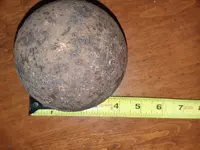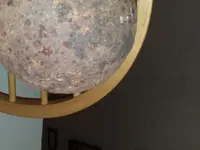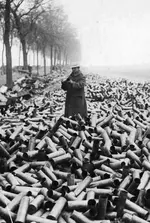Having driven a silver stake through the heart of the "blackpowder turns into nitroglycerine" fairytale/horror-story, I'll now use the same Scientific methods on Ballvalve's mystery-ball.
It absolutely is not a cannonball. That is proven by the ball's diameter-to-weight ratio. Going by the historical data in the US 1861 Ordnance Manual, a 3.58-inch diameter solid (not hollow) cast-iron ball weighs 6.1 pounds, and the same size (3.58"-diameter) hollow explosive one weighs 3.22 pounds (3 pounds 4 ounces). Ballvalve's ball is bigger (4-inches), and he says it weighs 1.56 pounds, so it is definitely not a hollow explosive cannonball.
Let's continue with what its diameter-to-weight ratio scientifically tells us. It is approximately 4 inches in diameter, and its LIQUID-FILLED weight is 708 grams / 1.56 pounds. One cup of water would almost exactly fill a 4-inch sphere, and a cup of water weighs approximately 236 grams. But because Ballvalve hears sloshing, it is not completely filled with water. It's not made of thin sheetmetal, which would have rusted through in some places. Its diameter-to-weight ratio indicates its wall thickness is about 1/8-inch, plus or minus a bit.
I'm just the guy here on TreasureNet who knows a heckuva lot about cannonballs... I'm absolutely certain this ball isn't a cannonball, but I don't know this ball's identification. Rock-crushing balls ("mill-balls") are always solid, so this isn't one of those. I'm just giving you the info above to help y'all figure out its ID.
 weighs a couple of pounds, sloshing inside when shaken. Any thoughts? Thanks!
weighs a couple of pounds, sloshing inside when shaken. Any thoughts? Thanks! weighs a couple of pounds, sloshing inside when shaken. Any thoughts? Thanks!
weighs a couple of pounds, sloshing inside when shaken. Any thoughts? Thanks!








